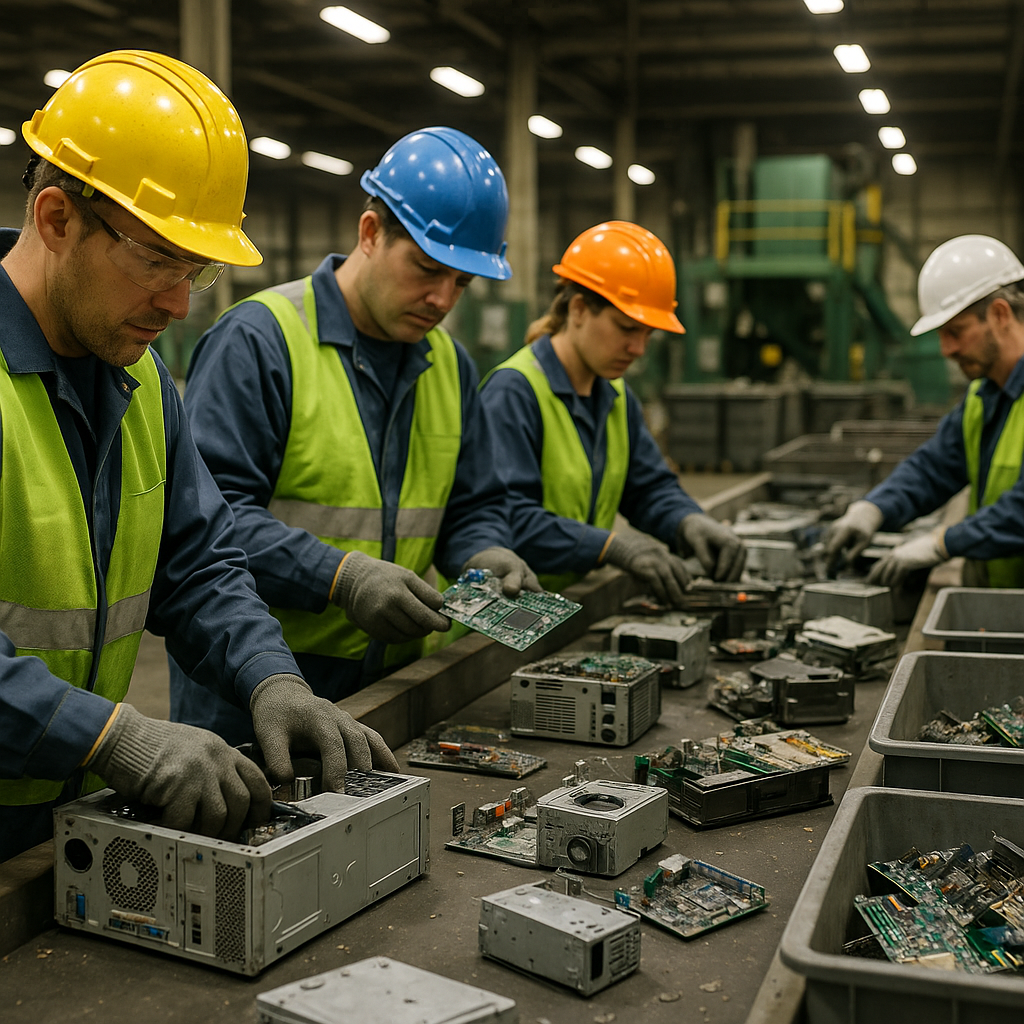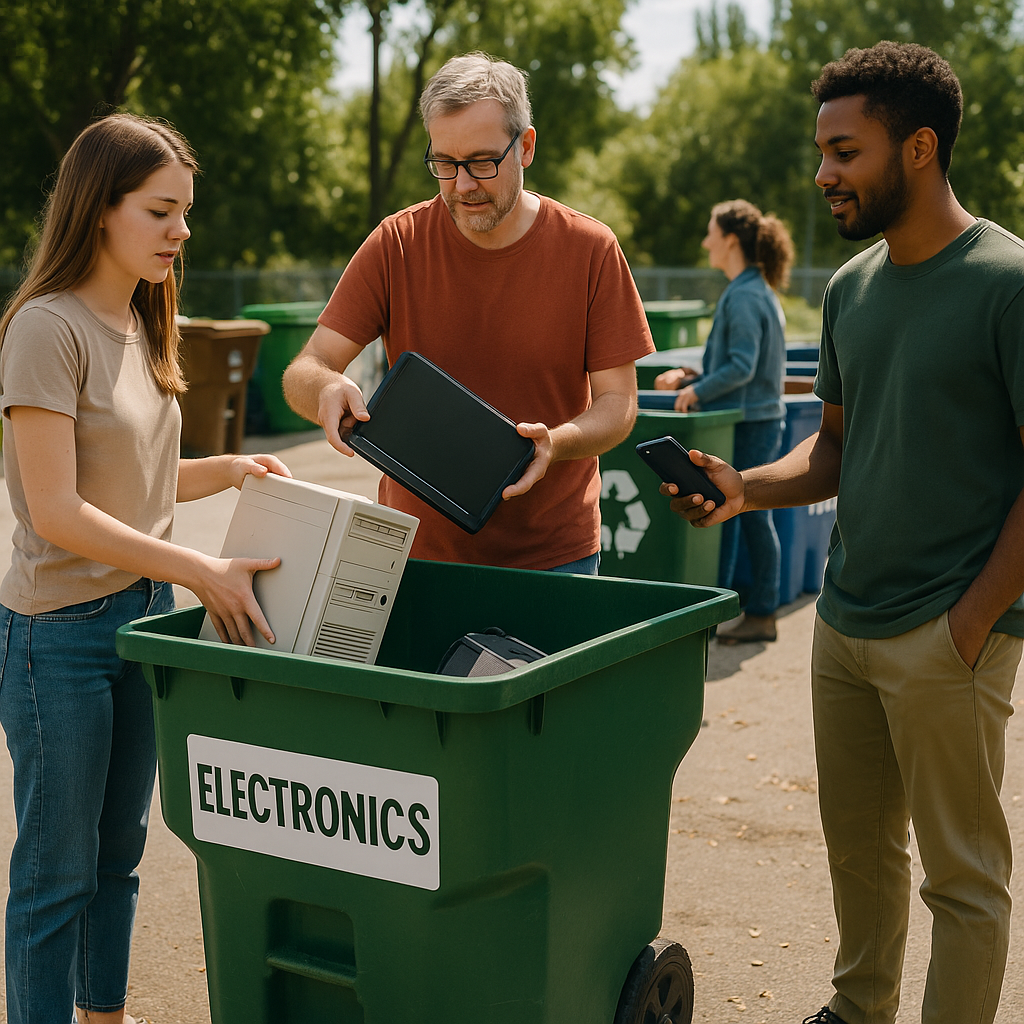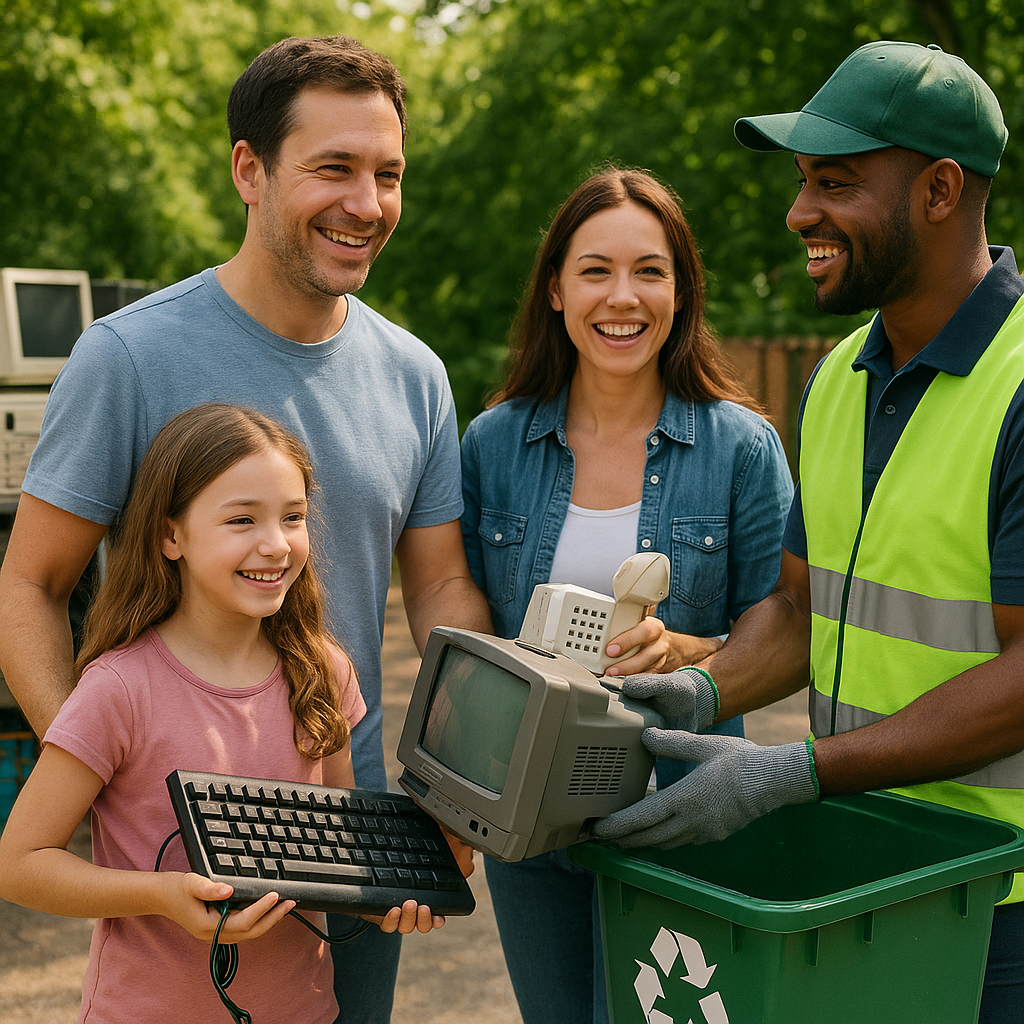5901 Botham Jean Blvd, Dallas, TX 75215
Electronics Recycling Explained: How to Recycle Old Phones, Laptops, and Gadgets
August 22, 2025Every second, approximately 1,000 laptops are discarded worldwide, contributing to the 62 million tons of electronic waste generated annually. This makes e-waste the fastest-growing waste stream on the planet. Electronics recycling offers a solution to this pressing issue.
Electronics recycling involves collecting, sorting, and recycling discarded electronic devices to recover valuable materials and reduce environmental impact. From smartphones and computers to printers and household appliances, these devices contain both precious resources and potentially harmful substances that require proper handling.
The importance of electronics recycling is immense. E-waste contains toxic materials like lead, mercury, and cadmium that can leach into soil and water when improperly disposed of in landfills. These toxins pose serious threats to both environmental and human health, potentially damaging vital organs and ecosystems. Through responsible recycling, we can prevent these hazardous materials from contaminating our environment while recovering valuable resources like gold, silver, copper, and rare earth elements that can be reused in manufacturing new products.
How Does the Electronics Recycling Process Work?

The electronics recycling process turns obsolete devices into valuable raw materials through a series of managed steps, each crucial for resource recovery while protecting the environment from harmful substances.
Collection: The First Critical Step
The recycling begins with collection. Organizations gather unwanted electronics through designated recycling bins, corporate collection programs, or scheduled pickup services. Some municipalities host special e-waste collection events where businesses and residents can drop off their old devices.
Collection methods vary based on volume and device type. Large businesses might arrange bulk pickups for office equipment upgrades, while smaller organizations might use drop-off centers. The key is ensuring these materials are properly recycled instead of ending up in landfills.
Safe Storage: Preventing Contamination
Once collected, electronics need appropriate storage until processing. This step prevents harmful substances from leaking into the environment and protects valuable components from damage. Storage facilities keep different types of electronics separated and secured.
Certain items demand special handling. Batteries, for example, are stored separately to prevent fire hazards. Devices containing mercury, such as some LCD screens, require careful handling to prevent toxic exposure.
Sorting and Assessment
Trained technicians sort incoming electronics by type and condition. Some facilities manually separate devices into categories: computers, printers, mobile phones, and other equipment. This initial sorting determines the appropriate recycling path for each item.
During assessment, technicians identify reusable components and devices requiring special handling due to hazardous materials. Items with toxic substances like lead or mercury are flagged for specialized processing.
Dismantling: Breaking Down Devices
Dismantling involves taking apart devices into their component pieces. Workers remove hazardous materials like batteries, toner cartridges, and mercury-containing parts. They also extract valuable components like circuit boards, which contain precious metals.
This labor-intensive process requires skilled technicians who understand how to safely disassemble various electronics. Some facilities use semi-automated systems to improve efficiency while maintaining safety standards.
Shredding: Size Reduction
After dismantling, the remaining materials are fed into industrial shredders that break them down into small, uniform pieces. This size reduction prepares materials for the separation phase by creating manageable fragments.
The shredding process increases the surface area of materials, making subsequent separation more effective. Modern shredders have dust extraction systems to capture potentially harmful particles, protecting both workers and the environment.
Material Separation: Sorting by Type
Advanced separation technologies sort shredded materials into distinct categories. This multi-stage process includes:
Magnetic separation pulls out ferrous metals like steel and iron. Non-ferrous metals such as aluminum and copper are separated using eddy current separators, which create magnetic fields that repel these metals from other materials.
Water separation techniques sort materials based on density differences. Plastics float while glass and certain metals sink, allowing for efficient separation. Air classification systems use controlled airflow to separate lighter materials from heavier ones.
Material Recovery and Refinement
The final stage transforms separated materials into market-ready commodities. Metals undergo smelting or refining to remove impurities. Plastics are sorted by type, cleaned, and processed into pellets for manufacturing. Glass is cleaned and prepared for use in new products.
Precious metals like gold, silver, and palladium, often found in circuit boards, undergo specialized recovery processes. These valuable materials represent a significant portion of the economic value recovered from e-waste.
Environmental Benefits
The electronics recycling process provides substantial environmental benefits. It conserves natural resources by reducing the need for raw material extraction. Proper e-waste management prevents toxic substances from contaminating soil and water supplies while reducing greenhouse gas emissions associated with manufacturing new products.
One ton of recycled electronics prevents approximately two tons of carbon dioxide emissions compared to extracting and processing raw materials. The process also recovers valuable metals that would otherwise remain unused in landfills.
What Should You Do Before Recycling Your Electronics?

Preparing your electronic devices properly before recycling is crucial for both data security and environmental protection. Taking the right steps ensures your personal information remains private and your devices are processed safely.
Consider upgrading your existing device before purchasing a new one. For computers and laptops, installing new hardware or software can often extend the life of your device and reduce electronic waste. This approach is both cost-effective and environmentally responsible.
If you decide recycling is necessary, prioritize data security. Simply deleting files or moving them to the trash isn’t sufficient. Deleting files only removes the pathway to the information, not the information itself. Experienced hackers can still access this data with recovery software.
Instead, perform a complete factory reset on your device. This process helps overwrite your personal data and returns the device to its original settings. For smartphones and tablets, look for the reset option in your settings menu. For computers, most operating systems include built-in tools for wiping your hard drive.
For businesses or individuals with sensitive information, consider using specialized data wiping software that overwrites deleted data multiple times, making it virtually impossible to recover. This extra security step is especially important for devices that contained financial records, medical information, or other confidential data.
Next, remove all batteries from your electronics before recycling. Lithium-ion batteries require special handling and should never be placed in regular trash or recycling bins, as they can cause fires when damaged during the recycling process. Many retailers and recycling centers have dedicated collection points for battery recycling.
Finally, research certified recycling facilities in your area. Look for recyclers with R2 or e-Stewards certifications, ensuring proper handling of electronic waste. These certified facilities follow strict guidelines for data security and environmental protection, providing peace of mind that your device will be recycled responsibly.
When choosing a recycling facility, verify their certifications and inquire about their data destruction policies. Some recycling centers offer certificates of destruction that document the proper disposal of your device and its data.
| Device Type | Pre-Recycling Step |
|---|---|
| Computers | Use disk cleaning software for data erasure, and physically remove batteries |
| Smartphones and Tablets | Perform a hard reset and remove memory and SIM cards |
| Office Equipment | Remove memory cards and perform a full manufacture reset |
| Digital Cameras and Media Players | Perform a factory reset and physically remove hard drives or memory cards |
Taking these steps not only protects your personal information but also ensures that valuable materials in your electronics can be recovered and reused, reducing the environmental impact of electronic waste.
Where Can You Recycle Your Old Electronics?

Local communities often host e-waste collection events where residents can drop off their unwanted electronics. These events are typically free and provide a secure way to dispose of items that contain sensitive data. Check your city’s official website or contact your local waste management department to find upcoming collection events in your area.
For businesses with larger quantities of electronic waste, certified electronics recyclers offer specialized services. Look for recyclers certified by reputable organizations such as e-Stewards or R2 (Responsible Recycling). These certifications ensure the recycler adheres to strict environmental standards and data security protocols.
When selecting a recycling option, consider both convenience and credibility. As some electronics contain hazardous materials like lead, mercury, and cadmium, improper handling can harm the environment. Additionally, personal data may remain on devices even after deletion. Certified recyclers have processes in place to safely destroy data and properly handle hazardous components.
State laws may also influence your recycling options. For instance, California’s Electronic Waste Recycling Act has established a comprehensive program for collecting and processing e-waste. Similarly, New York State mandates manufacturers provide free and convenient recycling services for certain electronic items. Familiarize yourself with your state’s regulations to ensure compliance.
Remember to prepare your devices before recycling by backing up important data and performing a factory reset when possible. For computers and smartphones, consider using specialized data wiping software to ensure your personal information cannot be recovered.
Conclusion: Making a Positive Impact Through Responsible Electronics Recycling

Proper electronics recycling is essential for protecting the environment and conserving resources. Recycling each device prevents toxic materials like lead, mercury, and cadmium from contaminating soil and groundwater. Individual efforts collectively yield significant environmental benefits.
By following data removal best practices and choosing certified recyclers, you protect your personal information and contribute to a more sustainable future. Recycling old smartphones or laptops helps recover valuable materials like gold, silver, and copper, which can be reused in new products. This process reduces the need for environmentally damaging mining activities while conserving limited natural resources. For all your electronics recycling needs, contact Okon Recycling at 214-717-4083.
